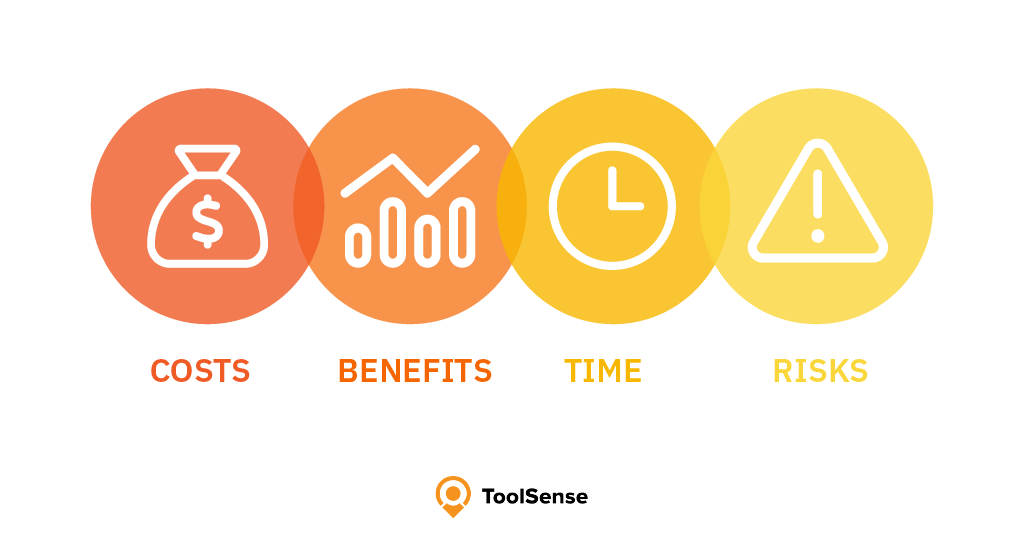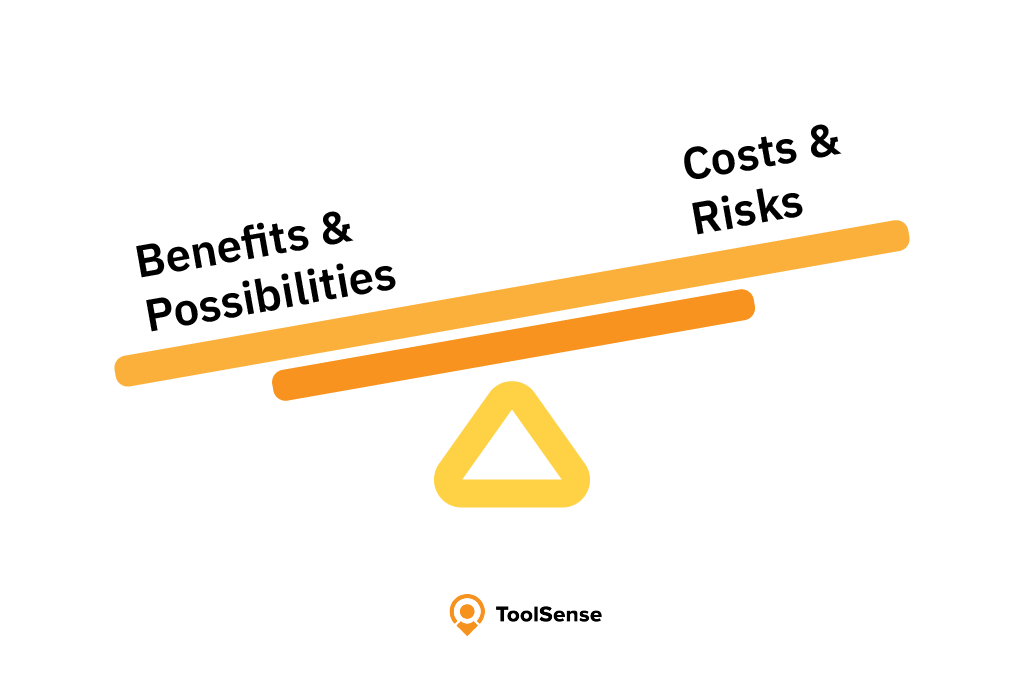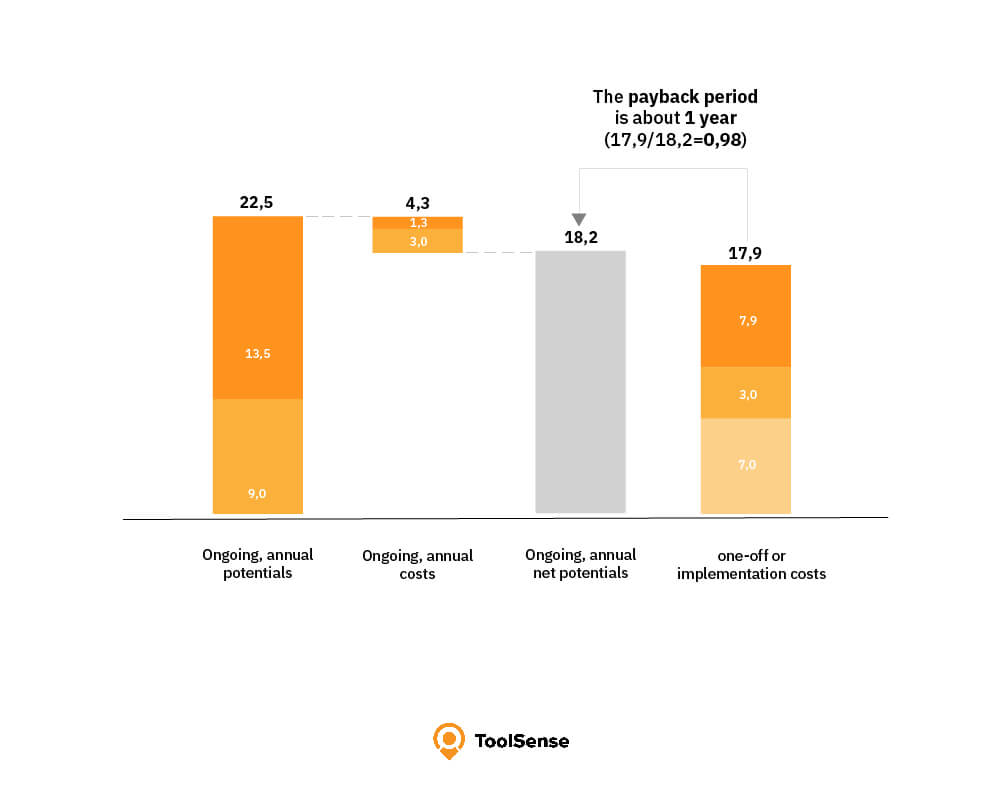Project planning, process improvements, and new ideas can move your company forward, but they are not always easy to push through – especially if they require a budget. You first have to convince your management to turn an idea into reality. To successfully present the project plan, it is recommended to prepare a solid business case. In this article, you will learn what a business case is, what it entails, and what it takes to create and successfully present your business case.

Key Takeaways
- A business case is a supplement to a project plan, in which the costs, benefits, risks, and schedule of a project are included.
- A business case is presented to executives and stakeholders to aid in the decision-making process.
- A well-prepared business case can help to identify risks at an early stage, plan resources, provide transparency and certainty, and secure financing.
Business Case: Definition and Comparison to Business Plan
A business case can – and often should be – submitted alongside a project plan. The definition states that it should contain the schedule, costs, benefits, and risks of the planned project. It also answers questions and lays out the consequences of not carrying out the project. Thus, the business case serves as a profitability analysis and the quantitative basis for the approval of an upcoming project. For the greatest possible transparency, a business case should also contain a comprehensible project scope and alternative options that take all possible effects of the project into account.
According to PRINCE2 guidelines, the following points should not be missing from a good business case:
- Executive summary
- Reasons why this project is needed
- Multiple options for the implementation process with individual assessments
- Expected benefits and potentials
- Expected negative effects
- Project schedule
- Project costs
- Capital budgeting
- Project risks
ToolSense is trusted by 700+ companies



The business case should not be confused with a business plan, which is primarily meant to determine general business goals and potential ways to achieve them. The business case, on the other hand, contains specific objectives for individual projects and plans. A business model is another term that can be easily confused with those already mentioned. However, it refers to the company’s basic functioning and organisation.

What Do You Need Business Cases For?
Building a business case is the perfect preparation for the implementation of the project. Open questions are clarified, risks are evaluated, and a project schedule is determined. Positive and negative effects are considered and, of course, the question of the budget is also clarified. The business case presentation – along with the project plan – prepares for a successful implementation.
The Main Benefits of a Business Case
Overview and Transparency
A well-developed business case provides a good overview of the planned project and its details, as well as monetary and non-monetary factors, creating clarity and transparency for all staff members and the project management.
Comparability and Prioritisation
As different options and possibilities are compared on paper, business cases are ideal to compare and prioritise different paths.
Securing Financing
The cost-benefit analysis listed in a business case provides a good template to calculate the needed budget to get financial appraisal from key stakeholders and secure funding for the project at an early stage.
Certainty for Your Decision-Making Process
As individual risks and costs of different paths are compared in a business case, you gain greater certainty in your decision-making process.
Early Risk Assessment
A solid business case evaluates risks and determines how to avoid them – long before the project actually begins. Therefore, project managers are informed very early on about all possible risks – including those that could or will arise if the project is not executed.
Smart Utilisation of Resources
Since a thorough cost-benefit analysis is part of a business case, resources can be planned and deployed in the best possible way. Therefore, strategic planning becomes much easier.
Compliance with Business Strategy and Business Plan
Business cases can show whether a project is in compliance with a company’s business plan or business strategy and how it can help achieve long-term goals.
Evaluating a Project Plan
Writing a business case requires concentration and discipline. Weaknesses in a project plan can be uncovered and eliminated before the final result is presented to relevant decision makers.

Key Elements of a Business Case
PRINCE2 provides a guideline for developing business cases, but the process is very individual and depends on the company and the project. However, the following points should be included in almost every solid business case:
1. Executive Summary
The executive summary is one of the most important parts of a business case because this first page must convince the executive level and management team of your idea. If you do not succeed on the first page, decision makers are unlikely to read the rest of the business case. For this reason, the situation, strategic objectives, schedule, alternative options, and recommendations should be summarised at the beginning. The current situation and the possible consequences of inaction should also be mentioned. Concise and convincing wording is particularly important.
2. Current Situation & Reasons for the Project
After the status quo has already been mentioned in the summary, it is presented in more detail in this section. Here, you should once again list all the consequences that a continuation of the current conditions would entail. That way, you convincingly lay out your reasoning as to why the projects need to be undertaken.
3. Alternative Solutions
At this stage, various options and your project scope are examined in more detail. This includes the advantages and disadvantages of different paths of implementation and how these options lead to the set goal.
4. Economic Viability and Expected Benefits
The project has a benefit or added value for your company. In some cases, this can be measured financially, and you can prove the profitability of the project through a calculation or cost-benefit analysis. Examples of financial benefits are an increased turnover rate or reduced operating costs. However, not all benefits are clearly measurable, such as increased customer or employee satisfaction. These benefits should nevertheless be mentioned in a compelling business case and, if possible, proven.

5. Risks
Oftentimes, potential disadvantages or risks arise with a project and that should be mentioned in a business case as well. A risk analysis is conducted to identify the risks clearly. You can also mention how these risks can be mitigated or avoided. Irrelevant side effects that are neither particularly positive nor negative can also be included in your business case.
6. Schedule
The project’s schedule was briefly mentioned in the summary and should be explained in more detail here. The start and end dates of the project should be clearly stated. Possible intermediate steps and fixed deadlines are also included in a business case.
7. Costs
The costs are of particular interest to relevant stakeholders and often decide whether a project can be undertaken. Therefore, you should compare costs and benefits on a time axis and calculate the return on investment (ROI) to convince executives of your project.
8. Evaluation and Recommendation
Individual options and actions are evaluated, and certain paths are recommended to the management level at the end of a business case.
Sign up now to access the latest market insights and improve your asset operations efficiency.
Business Case Checklist: The Five Most Important Success Factors
Realistic Assessment
One of the most important factors for the success of your business case is the realistic estimation of the new project. Can the set goals actually be achieved in the specified timeframe? Is the cost-benefit analysis plausible? In order to win over managers and stakeholders with a business case presentation, benefits should not be downplayed and figures not presented too optimistically.
A business case assessment can never accurately predict how much money an endeavour will actually cost or how much time it can really save. However, various business case calculations can help to estimate the current and future situation as accurately as possible. This is done, for example, through a time analysis or a cost-benefit analysis.
Implementation Approach
Realistic planning is also very important when working out the implementation path because the consequences of being too optimistic or ambitious can be severe. If intermediate targets are not met, the schedule cannot be adhered to and the profitability analysis becomes inaccurate. The budget may be exceeded, resources might not be procured on time, and employee satisfaction can decline.
For these reasons, it is important to plan the implementation carefully and realistically and to set appropriate milestones. This is the only way to accurately budget and procure resources in a timely manner. Realistic and precise planning of the implementation period also makes it more likely that managers will agree to the project.
One-Time Costs vs. Recurring Costs
A project – regardless of its scope, duration and nature – costs money, which means that the budget must be approved by stakeholders before the project can begin. For better clarity and comprehensibility, all costs should therefore be included in your business case calculation. This concerns both running costs and one-off costs.
Some costs, such as training for staff, are one-offs and can be seen as an investment. Other costs, however, such as the annual or monthly licence fees for software, are part of the recurring costs and must be calculated against the project’s benefits. Suitable ways to calculate this are the break-even analysis described in the next section or a calculation of the payback period.
Payback Period and Break-Even Analysis
In addition to whether a project is profitable, stakeholders are also interested in when the project will be profitable. There are two methods of determining this. The first method is a break-even analysis, in which the break-even point – the point at which expenditure and profit balance each other out – is calculated. The various variable or fixed costs and the profits are included in the calculation.
Calculating the payback period is another way to find out how long it will take for costs to be recouped by the investment. Capital budgeting provides information about the risk of the investment. The aim is to keep the payback period as short as possible in order to reduce the risk.
These or both values should always be considered in a business case calculation. With precisely calculated values, management levels can make their decision more easily and carefully.
Preparing a Good Presentation
A business case presentation should never be improvised or delivered carelessly because the success of the project also depends on how the proposal is presented to managers. The results should always be mentioned first, since these are the most important facts that contribute to the decision. Therefore, you should pay close attention to your calculation to avoid bogus accuracy and convey these figures as precisely as possible. Visual image are also popular to make a better and more lasting impression. Graphics, pictures, or tables in various forms create a special presentation experience.

Business Case Example: How an Asset Management Software Like ToolSense Improves Processes for Construction Companies
To illustrate its importance, we have compiled a business case example based on a fictional but realistic construction company. The construction industry is particularly well suited for a business case example in which the implementation of an asset management solution is examined. That is because the construction industry is one of the least digitised industries in Germany. A lot of manual labour is still required, countless phone calls and emails are exchanged, Excel lists are maintained, and analogue documents are sorted. This creates a huge optimisation potential to reduce working hours, downtime, and asset costs with the help of cloud-based software and automated tracking equipment. ToolSense’s asset management software will be used for this purpose.
Overview and Outline of the Business Case
The exemplary construction company has approximately 45 employees and a machine park of 20 large construction machines and about 100 smaller machines. These include assets such as excavators or concrete core drills. The aim of this project is to improve the planning and scheduling processes by implementing ToolSense’s asset management software and associated asset-tracking hardware. For this purpose, the entire machine park is first inventoried and a digital twin of all equipment is created, to which all employees have access via software. This ensures that every staff member works with the same level of information, regardless of department.
Business Case Calculation: Economic Efficiency and Expected Benefits
Implementing ToolSense eliminates the need to maintain multiple Excel lists, folders, and documents, as all the information around each asset is stored in a cloud-based platform. This can be used to manage machines and equipment in different locations. Emails, phone calls, and written correspondence are no longer necessary.
The process of searching for, collecting, and reconciling data is eliminated, as are cumbersome communication methods. As a result, approximately €9000 can be saved in one year. With almost 200 working days per year, ToolSense saves one hour per day and employee, i.e. €45 per day in employee costs.
Likewise, automated tracking equipment, such as telematics solutions or Bluetooth trackers, has a great savings potential. In the past, searching for equipment or machine parts took about 1.5 to 2 hours. Therefore, a savings potential of €13,500 to €18,000 per year can be assumed.
This results in a total annual potential of at least €22,500, which can be saved by using ToolSense. Further savings are possible, for example through optimal use of machinery (transport costs, transport times, …), but depend on how the company will use the software in the future.

Implementation Path and Costs
The implementation of ToolSense is simple, but still requires more than a few minutes. First, the cloud server is set up and the software is made available to the customer. Then the data import is carried out. Thanks to Excel compatibility, this is particularly quick and smooth with ToolSense, as existing lists can be easily imported.
The ToolSense platform is extremely user-friendly and intuitive. However, training of the appropriate team members can take place after successful installation to explain the software and its use to all members of staff.
For newly acquired assets or machines that have not been integrated into the software through an Excel import, the next step is to connect the individual devices to the ToolSense platform. Here, ToolSense GPS sensors or trackers can be used to monitor the machines. Alternatively, the software provides an individual QR code that can be assigned to a machine and attached to it.
ToolSense requires a one-time implementation fee of approximately €7,000. In addition, there are monthly licence fees of approximately €250 (or €3,000 per year). ToolSense has a practical QR code function that can be used to track different machines. Nevertheless, especially for motorised equipment, hardware solutions based on telematics or Bluetooth are a good choice. One-time costs of €7,500 (20*€135 + 100*€52) are due for the hardware. The running costs for data transmission amount to €110 per month (or €1,320 per year). This results in one-time costs of €17,900 and annual, recurring costs of €4,320.
Summary
After deducting the recurring annual costs (€4,320), a net potential of at least €18,180 remains in this example. The one-time implementation costs of €17,900 for ToolSense can therefore be amortised in the first year after the implementation of the project. The digitisation of many once analogue administrative tasks creates easier workflows for employees, especially for property managers, and thus increases employee satisfaction and productivity. ToolSense’s asset and maintenance management solution also contributes to the reliability of your machines through better maintenance management, which not only reduces downtime but also increases customer satisfaction.

Conclusion
Presenting a project plan to the management level is often not enough to convince executives of your idea. You need strong arguments, precise figures, and enough alternative solutions of action to win over your managers. All this and more is contained in a carefully prepared business case that compares risks, costs, and benefits and convincingly highlights all the advantages and success criteria of the project with relevant research. With a solid business plan, you can present your ideas in the best possible way.
ToolSense is trusted by 700+ companies



FAQ
A business case is submitted alongside a project plan and contains the costs, benefits, risks, and schedule of a project. Issues and consequences of maintaining the status quo are also mentioned.
At the heart of each business case is a thorough business case analysis, whose results are recorded to make a case. Business case templates and examples can be downloaded from the internet.
Every business case should include an executive summary, reasons why the project needs to be undertaken, risks, and a cost-benefit analysis.
When a business case is developed, it follows a 5-case-model, including the strategic case, the socio-economic case, the commercial case, the financial case, and the management case.

